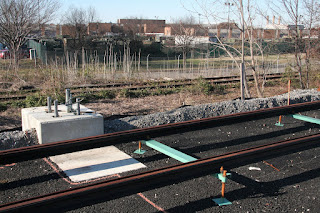They're here! The three Skoda-Inekon (Czech Republic) streetcars purchased several years ago by the District of Columbia's DOT floated into the Port of Baltimore Saturday, December 12, 2009. According to a DOT press release (and a Dec 16 story in The Washington Post), the three were offloaded to flatbed trucks and taken for storage to Metro's Greenbelt, Md. yard until the streetcar line is completed.
In the picture below, two of the cars are shown resting on ACLU-marked trailers of a type that apparently has tires and axles that fold flat underneath until needed for the highway:

 Greenbelt, here we come!
Greenbelt, here we come! The DDOT photos above plus about a dozen more were posted to the Department's Facebook page at http://tinyurl.com/ykfnymx but you need an account to access them. The page also has a video of the unloading, plus another of the similar Portland, Oregon streetcar system. A press release with a couple of pictures is available at the DOT's public site:
The DDOT photos above plus about a dozen more were posted to the Department's Facebook page at http://tinyurl.com/ykfnymx but you need an account to access them. The page also has a video of the unloading, plus another of the similar Portland, Oregon streetcar system. A press release with a couple of pictures is available at the DOT's public site:What about tracks on which to run these new cars? They're currently under construction in downtown D.C. along H Street NE, and in Anacostia. On Tuesday, December 15, I paid a second visit to the Anacostia project. (A report on my first visit, on September 29, can be found farther down this blog.)
This recent visit revealed little had changed at the north end of the line. Driving north up Firth Sterling Avenue revealed trackage has been installed no farther north than the intersection with Suitland Parkway. (I did not drive the rest of the projected route up MLK, Jr. Avenue on this visit, however, so I can't say for sure if construction has begun there.)
The construction I did see has been focused instead on the southern end, which bends south from Firth Sterling under the I-295 overpass onto the west side of South Capitol Street and proceeds south until it runs out in the bushes. The following map shows the area I covered during this visit, highlighted in bright yellow and marked at each end by a red "X":

The photo below shows the north end of the new streetcar trackage, so far as I know. The camera is looking north from Firth Sterling Avenue at the intersection with the west end of Suitland Parkway. The old-looking tracks in the street are, in fact, the new streetcar tracks. The true "old" tracks, those of the ex-B&O/CSX Shepherd Branch, had been a few feet to the right but have been pulled up. Note to those clinging to faint hope that the Shepherd Branch may one day be reactivated: Nuh, uh. It exists only in pieces today.

Backing south from the intersection with Suitland Parkway and shooting north again:

Turning around and shooting south on Firth Sterling at the Sumner Road intersection. Construction work to the right of the Jersey wall appears not to be rail-related:

A closer look at the same location:

Backing even farther south along this stretch and shooting back north toward Sumner Road and Suitland Parkway. At first I thought that "pole line" on the right was put in for catenary supports, but it looks too raggedy and unreliable. At some point we'll probably see steel structures going up and poles coming down:

And now, imagine spinning around in place and shooting in the opposite direction. The highway overpass is I-295. As the tracks pass underneath they turn south, cross South Capitol Street, and continue on the west side of that highway along a new right of way isolated from traffic:


From the opposite side of the I-295 overpass, looking back at ongoing construction--although for the life of me I can't figure out what's it for. The streetcar trackage appears to have already been completed here:

Zooming back reveals a trackage gap in the middle of South Capitol Street:

Walking across South Capitol Street, one comes upon the continuation of the line that came to an end in the photo above. This view looks due south--right into the sun, unfortunately. Note the heavy asphalt base:

In this picture I've continued south down South Capitol Street and will continue to do so in the remaining photos. The line of plastic barrels provided an excellent, safe barrier and parking space for my Jeep, which I simply kept moving south. This view, looking back north, shows rail supported by finely-adjustable jacks at their final, pre-determined height:

Two phases of track construction are visible here, the first being the rail supported only by jacks (top half of picture). The lower half, however, shows the next phase, where a cage-like structure made of rebar has been inserted under the rail and between the jacks just prior to the pouring of concrete:





"The end is near." So far, the southern end of the line peters out at the end of this picture:


Looking back north from the south end of the line:






And here it is: The end. Where will it go from here? It appears the line will go even farther after some brush-clearing and embankment reinforcement. I had hoped to find construction underway for the car barn that's to be built in this vicinity, but not yet.


























